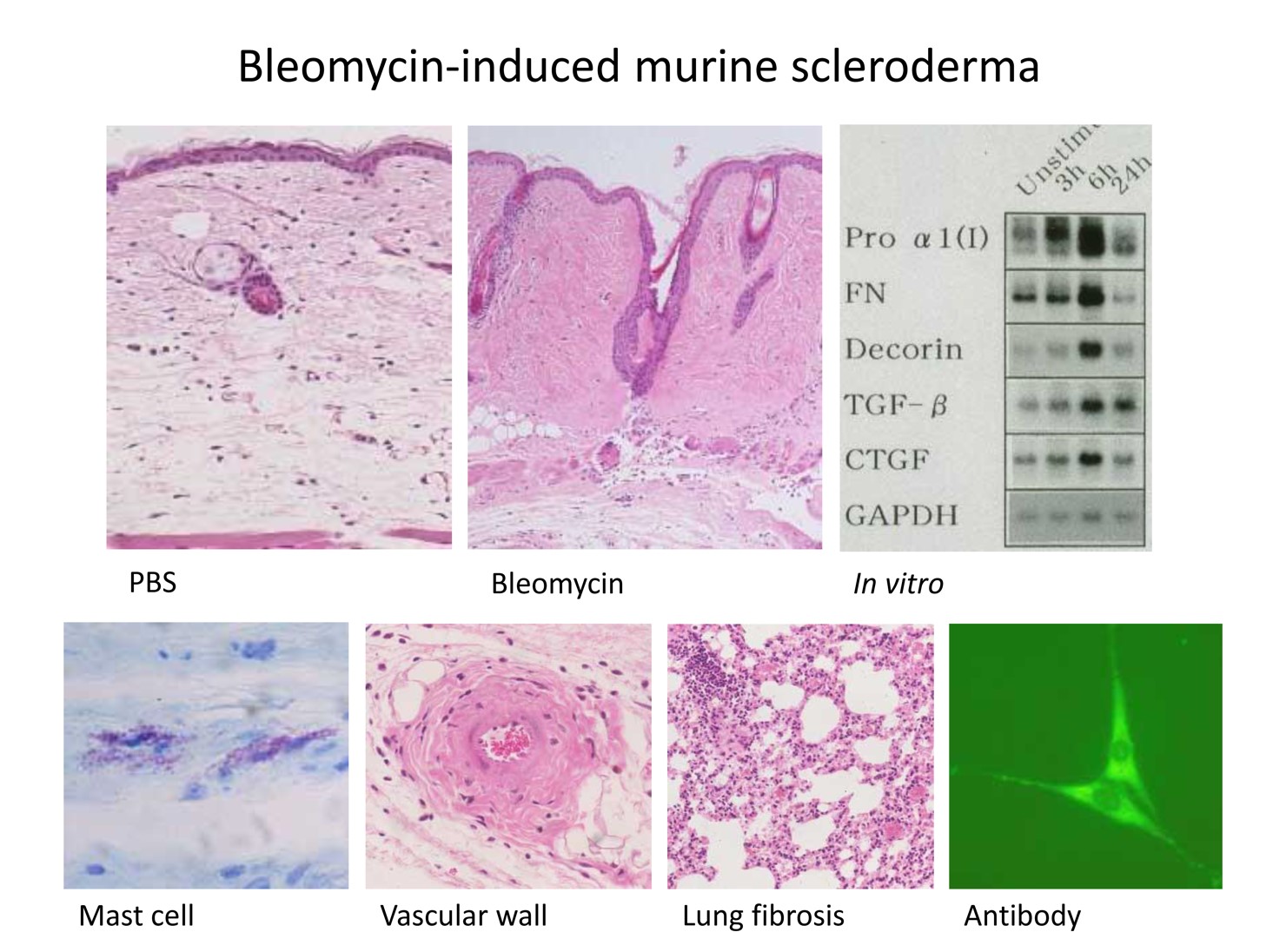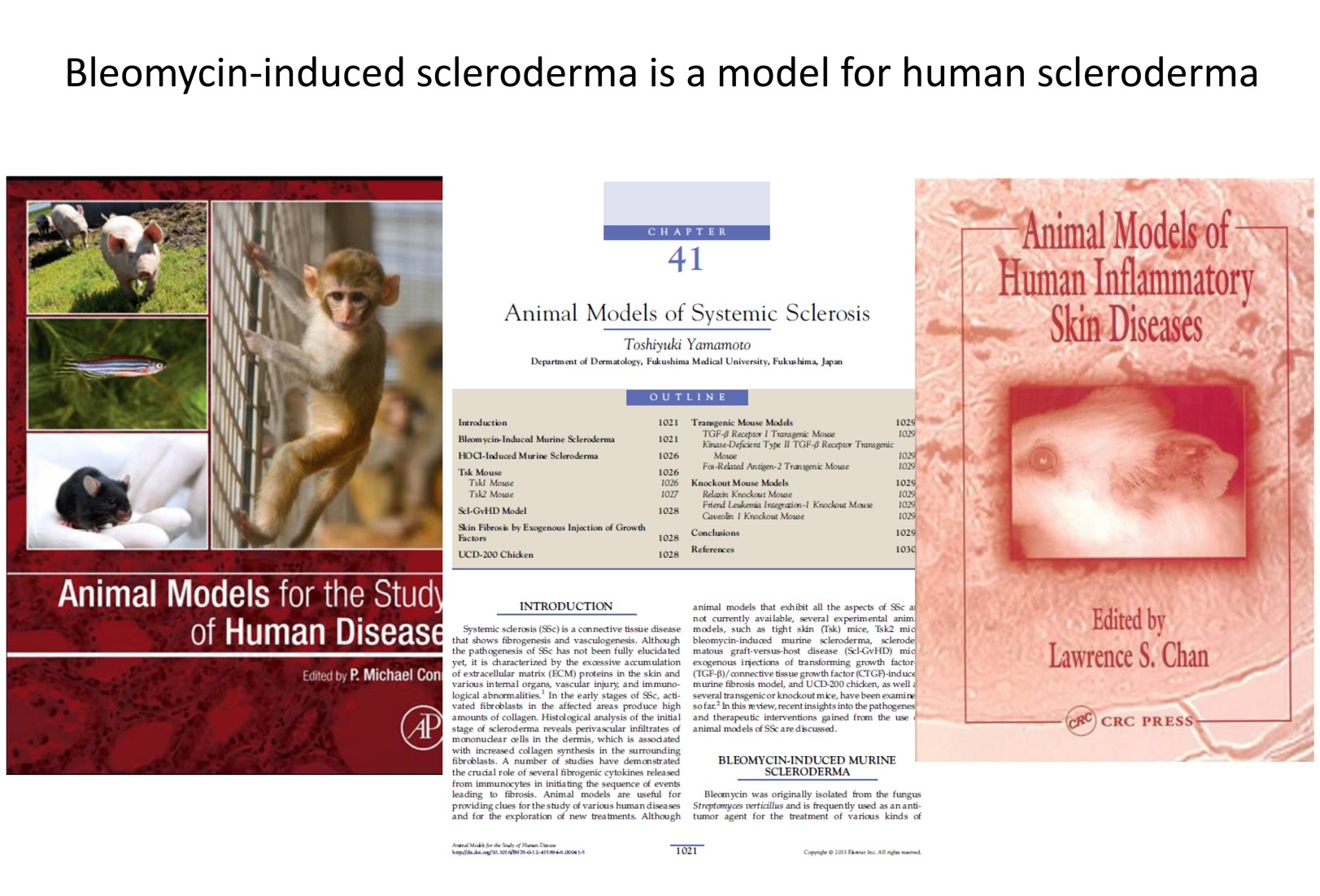強皮症の研究
全身性強皮症は、皮膚を始め、内臓諸臓器に線維化・硬化をきたす結合織疾患である。その病態は、1) 免疫異常を背景に、2) 血管内皮細胞の障害をトリガーとして、最終的に、3) 活性化された線維芽細胞から、過剰な細胞外基質蛋白が産生され、局所に沈着する、という3つの側面から考えられている。主に、線維化を誘導する様々なサイトカイン、ケモカインの方面から、これまで研究がなされてきたが、強皮症研究は、他の膠原病に比べ遅れてきたと考えられてきた。その理由の一つに、適切な動物モデルが稀少であるということが挙げられる。
当科の山本が作成した強皮症モデルマウスは、強皮症研究のブレークスルーとなり、世界の強皮症研究に大きく貢献した。特徴は、方法が簡便で、短期間に、誰にでもでき、再現性が高いため、このモデルは、今や世界中で利用され、強皮症モデルというと、このモデルを指すまでになっている。他にも、遺伝子改変動物を利用したモデルなどはあるが、容易に作成でき、誰もが利用できるものはない。

このように強皮症研究は、病変部由来の線維芽細胞を使った、in vitroの研究と並行して、in vivoでの研究が進んだお蔭で、ここ数年飛躍的に病態解析は進んできた。この動物モデルは、強皮症の病態解明だけでなく、新たな治療法の開発にも寄与する。ただし、様々な治療薬の候補が研究されてはいるものの、未だに実用化されたものはほとんどないのが現状である。実際の患者さんへの治療という点では、まだまだ臨床現場へ還元できるには満足する結果ではない。引き続き、検討していく所存である。

強皮症モデルに関するこれまでの研究成果
1. Yamamoto T, Takagawa S, Katayama I, Yamazaki K, Hamazaki Y, Shinkai H, Nishioka K. "Animal model of sclerotic skin. I: Local injections of bleomycin induce sclerotic skin mimicking scleroderma." J Invest Dermatol 1999; 112: 456-462.
2. Yamamoto T, Takahashi Y, Takagawa S, Katayama I, Nishioka K. "Animal model of sclerotic skin. II: Bleomycin induced scleroderma in genetically mast cell deficient WBB6F1-W/Wv mice." J Rheumatol 1999; 26: 2628-2634.
3. Yamamoto T, Kuroda M, Takagawa S, Nishioka K. "Animal model of sclerotic skin. III: Histopathological comparison of bleomycin-induced scleroderma in various mice strains." Arch Dermatol Res 2000; 292: 535-541.
4. Yamamoto T, Nishioka K. "Animal model of sclerotic skin. IV: Induction of dermal sclerosis by bleomycin is T cell independent." J Invest Dermatol 2001; 117: 999-1001.
5. Yamamoto T, Nishioka K. "Animal model of sclerotic skin. V: Increased expression of α-smooth muscle actin in fibroblastic cells in bleomycin-induced scleroderma." Clin Immunol 2002; 102: 77-83.
6. Yamamoto T, Nishioka K. "Animal model of sclerotic skin. VI: Evaluation of bleomycin-induced skin sclerosis in nude mice." Arch Dermatol Res 2004; 295: 453-456.
7. Yamamoto T, Takagawa S, Katayama I, Nishioka K. "Anti-sclerotic effect of anti-transforming growth factor-? antibody in bleomycin-induced scleroderma." Clin Immunol 1999; 92: 6-13.
8. Yamamoto T, Takagawa S, Mizushima Y, Nishioka K. "Effect of superoxide dismutase on bleomycin-induced dermal sclerosis: Implications for the treatment of systemic sclerosis." J Invest Dermatol 1999; 113: 843-847.
9. Yamamoto T, Takagawa S, Kuroda M, Nishioka K. "Effect of interferon-? on experimental scleroderma induced by bleomycin." Arch Dermatol Res 2000; 292: 362-365.
10. Yamamoto T, Takagawa S, Nishioka K. "Mast cell-independent increase of type I collagen in bleomycin-induced scleroderma." Arch Dermatol Res 2001; 293: 532-536.
11. Yamamoto T, Nishioka K. "Analysis of the effect of halofuginone on bleomycin-induced scleroderma." Rheumatology 2002; 41: 594-596.
12. Yamamoto T. "Animal model of sclerotic skin induced by bleomycin: A clue to the pathogenesis of and therapy for scleroderma?" Clin Immunol 2002; 102: 209-216.
13. Takagawa S, Lakos G, Mori Y, Yamamoto T, Nishioka K, Varga J. Sustained activation of fibroblast transforming growth factor-?/Smad signaling in a murine model of scleroderma. J Invest Dermatol 2003; 121: 41-50.
14. Yamamoto T, Nishioka K. "Role of monocyte chemoattractant protein-1 and its receptor, CCR-2, in the pathogenesis of bleomycin-induced scleroderma." J Invest Dermatol 2003; 121: 510-516.
15. Yamamoto T. "Experimental animal models for scleroderma: Recent advances." Recent Research Developments in Immunology 5; p363-373, 2003. Research Signpost
16. Yamamoto T, Nishioka K. "Possible role of apoptosis in the pathogenesis of bleomycin-induced scleroderma." J Invest Dermatol 2004; 122: 44-50.
17. Oi M, Yamamoto T, Nishioka K. "Increased expression of TGF-?1 in the sclerotic skin in bleomycin-'susceptible' mouse strains." J Med Dent Sci 2004; 51: 7-17.
18. Matsushita M, Yamamoto T, Nishioka K. "Upregulation of interleukin-13 and its receptor in a murine model of bleomycin-induced scleroderma." Int Arch All Immunol 2004; 135: 348-356.
19. Wu M-H, Yokozeki H, Takagawa S, Yamamoto T, Satoh T, Kaneda Y, Nishioka K. "Hepatocyte growth factor both prevents and ameliorates the symptoms of dermal sclerosis in a mouse model of scleroderma." Gene Ther 2004; 11: 170-180.
20. Yamamoto T. Experimental mouse model of scleroderma: Induction by bleomycin. Animal Models of Human Inflammatory Skin Diseases. p535-547, 2004, CRC Press
21. Matsushita M, Yamamoto T, Nishioka K. "Plasminogen activator inhibitor-1 is elevated, but not essential, in the development of bleomycin-induced murine scleroderma." Clin Exp Immunol 2005; 139: 429-438.
22. Yamamoto T, Nishioka K. "Increased expression of p53 and p21 (Waf1/Cip1) in the lesional skin of bleomycin-induced scleroderma." Arch Dermatol Res 2005; 296: 509-513.
23. Yamamoto T. "Characteristics of animal models for scleroderma." Curr Rheumatol Rev 2005; 1: 101-109.
24. Yamamoto T, Nishioka K. "Cellular and molecular mechanisms of bleomycin-induced murine scleroderma: Current update and future perspective." Exp Dermatol 2005; 14: 81-95.
25. Yamamoto T. The bleomycin-induced scleroderma model: what have we learned for scleroderma pathogenesis? Arch Dermatol Res 2006; 297: 333-344.
26. Yamamoto T, Matsushita M, Yokozeki H. Role of cytokines in scleroderma: Use of animal models. Clin Appl Immunol Rev 2006; 6: 1-19.
27. Yamamoto T. Apoptosis in scleroderma: Current insights into the role of apoptosis in human as well as animal models of scleroderma. New Cell Apoptosis Research. pp37-52, 2007, Nova Science Publishers, Inc.
28. Yamamoto T. "Scleroderma-Pathophysiology." Eur J Dermatol 2009; 19: 14-24.
29. Yamamoto T. "Animal model of systemic sclerosis." J Dermatol 2010; 37; 26-41.
30. Kajii M, Suzuki C, Kashihara J, Kobayashi F, Kubo Y, Miyamoto H, Yuuki T, Yamamoto T, Nakae T. "Prevention of excessive collagen accumulation by human intravenous immunoglobulin treatment in a murine model of bleomycin-induced scleroderma." Clin Exp Immunol 2011; 163: 235-241.
31. Yamamoto T, Katayama I. "Vascular changes in bleomycin-induced scleroderma." Int J Rheum 2011; 2011: 270938.
32. Wakatsuki-Nakamura T, Oyama N, Yamamoto T. "Local injection of latency-associated peptide (LAP), a linker propeptide specific for active form of transforming growth factor-beta1 (TGF-β1), inhibits dermal sclerosis in bleomycin-induced murine scleroderma." Exp Dermatol 2012; 21: 189-194.
33. Yamamoto T. "Animal models of systemic sclerosis. Animal models for the study of human disease." Edited by P. Michael Conn, Academic Press. pp1021-1035, 2013.
34. Yamamoto T. "Reactive oxygen species and scleroderma. Systems biology of free radicals and anti-oxidants." Edt I. Laher (UBC, Canada). Springer-Verlag (Germany). pp3737-3752, 2014.
35. Ohashi T, Yamamoto T. "Antifibrotic effect of lysophosphatidic acid receptors LPA1 and LPA3 antagonist on experimental murine scleroderma induced by bleomycin." Exp Dermatol. 2015 Sep;24(9):698-702.
36. Mori T, Tamura N, Waguri S, Yamamoto T. "Autophagy is involved in the sclerotic phase of systemic sclerosis" Fukushima J Med Sci. 2020; 66: 17-24.
37. Ishikawa M, Yamamoto T. "Antifibrogenic effects of C-C chemokine receptor type 2 antagonist in a bleomycin-induced scleroderma model" Exp Dermatol. [Online ahead of print]

